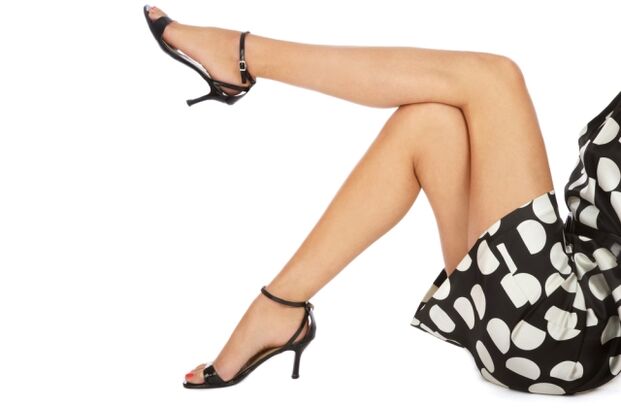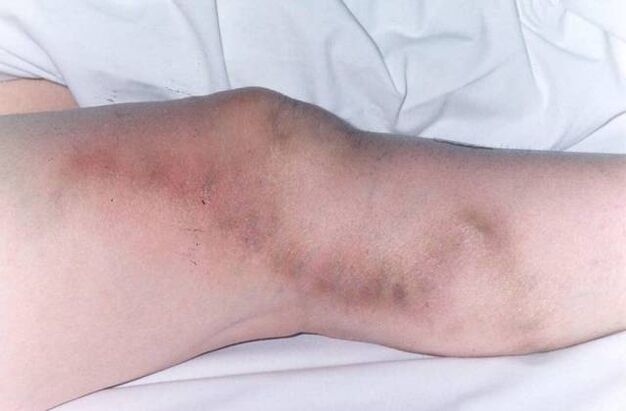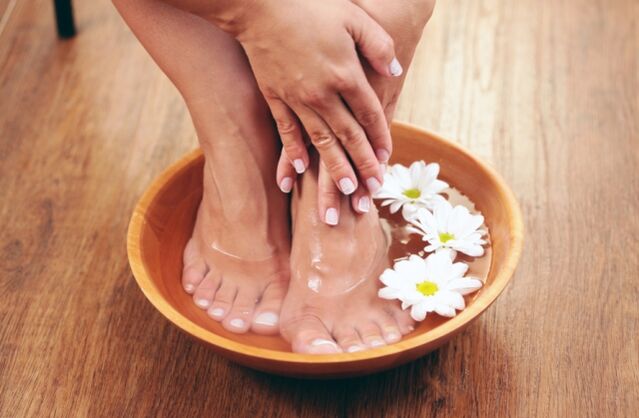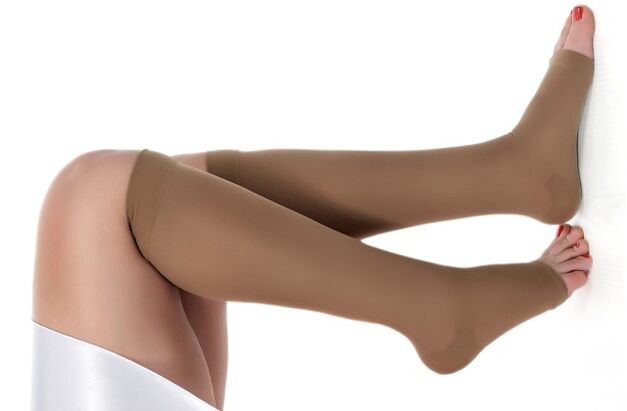A disease of the veins that changes in shape, increases in size, and decreases in elasticity, called varicose veins. With varicose veins, damage and degenerative changes occur to the valves and walls of these blood vessels, which are located just below the surface of the skin.
causes of varicose veins

Blood flow in the venous system is characterized by a major upward movement against gravity. To prevent its reverse movement, on the inner wall of the vein there are valves - pockets. When filled with blood, they close, closing off the lumen of the blood vessel, allowing blood to pass in only one direction - from the bottom to the top. Because the valves are not functioning properly, blood can build up in the veins, and they start to stretch and elongate in a bag-like fashion, becoming tortuous, leading to varicose veins. There are several theories to explain the appearance of a dysfunctional valve in the vein.
- Valve insufficiency theory. Varicose veins occur due to improper redistribution of blood in the venous system, located deep in the superficial vascular network. This is due to congenital absence or insufficiency of the communicating vein valve.
- Neuroendocrine Theory. Varicose veins occur due to hormonal changes (adolescence, pregnancy, menopause) that cause less tension throughout the venous network. Abnormalities of the endocrine system can lead to increased venous blood supply, dilation of the venous lumen, thinning of the vessel wall, and poor valve patency.
- mechanics theory. Standing for long periods of time, venous compression leads to increased intravascular pressure in the extremities.
Early and subsequent signs of varicose veins. complication

In the early stages of varicose veins, there are no painful symptoms. Early signs of illness include: heaviness, fullness, fatigue, burning sensation in the legs. In the future, they may also experience the following symptoms: itchy skin, pain and cramping of the calf muscles. There are soft tissue seals, dark pigmented spots. Over time, thickening, curling, and cystic expansion of the nodule become clearly visible. The phrase "varicose veins" means "multiple knots, with multiple thickenings. "With varicose veins, serious complications can occur, such as:
- acute thrombophlebitis (inflammation of the blood vessel wall and the formation of blood clots);
- Bleeding with minor damage to blood vessels due to physical stress, overheating;
- Form trophic ulcers, eczema, erysipelas.
Treatment of varicose veins is a lengthy process that requires a comprehensive approach. It is important to use all available means and treatments aimed at further stopping the development of varicose veins and treating possible complications.
Alternative ways to treat and prevent varicose veins

Bioactive substances in traditional medicine restore the normal appearance and tone of blood vessels and skin, helping to restore adequate blood circulation in the veins. Below are the most effective and proven formulas for extracts, decoctions, lotions, and rubs for varicose veins.
- Treating varicose veins with acacia tincture helps dissolve the varicose veins. Prepare as follows: 30-40 grams of acacia stick vodka for 7 days. Lubricate the painful area 3-4 times a month, once a day.
- Fresh clove leaves are washed and applied to the painful area and secured with a bandage. Hold for 30 minutes. From the leaves of cloves, you can also prepare a cooling decoction in which gauze is moistened and wrapped around the legs for 30 minutes. Treatment should be continued for at least 8 weeks.
- Peeled and grated horseradish is placed on the leg and secured with a bandage. After 10-20 minutes, remove the compress and rinse the legs with water.
- Add a tablespoon of apple bites and the yolk of an egg to 1 teaspoon of turpentine and mix in an enameled pan. Rub the sore spot every night. Treatment continued for 3 months.
- Slice the washed tomato, wrap it in a bandage, and stick it to the leg. The dressing is left on for 2-3 hours, then replaced with a new one. The number of replacements is 3-4 times.
- The affected area of the leg is initially washed with laundry soap, baking soda is poured over it, and covered with white cabbage leaves. The compress was fixed and left overnight. Varicose veins will decrease significantly within 4-6 months.
- Angelica is very effective in treating varicose veins. It is poured with alcohol in a ratio of 1: 4, left in a dark place for 7 days, and the resulting tincture is then rubbed on the painful area for a long time.
The best folk remedies to reduce blood clotting, eliminate vasospasm, strengthen vein walls and capillaries to treat varicose veins are creams and ointments containing extracts of hop cones, thyme, horsetail, red grape leaves and peppermint. The essential oils contained in it increase blood circulation in the veins and have a cooling effect. This folk ointment formula is effective in treating varicose veins with excellent results.
- Ointment 200 g. Lard, 150 g. Pine resin, 150 g beeswax. In a water bath, all components were melted and mixed, and 20 g were slowly added to the resulting composition. Propolis. Pour in 2 tablespoons after cooling. spoon honey. When hot, transfer the ointment to linen or gauze and wrap the legs overnight. Treatment gives results in the second week.
- The ointment is made from 3 parts refined lard and 1 part pharmacy bile. It is applied in a thin layer to the varicose veins without rubbing.
- Mix 0. 5 tsp. 3 tsp starch. Chamomile powder and 5 tsp. ground chestnuts. Pour the resulting powder into the hot duck fat and keep the ointment in the steam bath for 2 hours. Lubricate the area of varicose veins morning and evening.
- Mix one egg yolk, honey, and vodka. The mixture is applied to the dilated vein, covered with polyethylene and wrapped warm. The ointment is used at night for a month.
This folk remedy for varicose veins, such as a decoction, is administered orally. At the same time, they not only have a local effect on the affected blood vessels, but also purify the blood and reduce its viscosity, thereby improving its current flow. Here are some recipes.
- Treat varicose veins with thistle decoction. Cut off the flowering tops of the thistles and place in a bowl, pour in water and bring to a boil. The resulting decoction was administered orally in 40 drops for 14 days, followed by a 14-day break and an additional two weeks. The treatment is divided into three courses.
- 200 grams of grated nutmeg tincture and 1 liter of vodka aged for 12 days. The infusion is then squeezed and filtered. Receive 15 drops, 4 times a day. Varicose veins will no longer bother you.
- Combine 4 parts horse chestnut flowers, 1 part fragrant bison, 2 parts yarrow, mint - 4, plantain leaves - 2, hops - 2, lingonberry leaves - 2, chicory root - 4. 1 tablespoon. l. Pour the mixture into 300 ml. Boil water and let stand for 2 hours. Take half an hour before meals, 100 ml, 4 times a day.
In diagnosing varicose veins, it is very useful to take folk remedies that have blood-purifying properties. A good verbena soup (not sick) is 3 tablespoons. l. From unpleasant cosmetic problems caused by varicose veins, these folk recipes will help to get rid of them.
- Rub apple cider vinegar on varicose veins in the morning and before bed. This process is repeated for 2-3 weeks for 5 minutes.
- 2. Mix sour cream and fresh viburnum leaves into gruel (ratio 2: 1) and compress overnight. Do it for 2 weeks.
- 3. Take a footbath with an aqueous tincture of oak bark and willow root (1: 5) before bed.
Home remedies and ways to prevent varicose veins

Treating varicose veins at home should start with simple steps to keep your legs active and healthy. A simple physical exercise in the morning strengthens the muscle corset and makes the legs stronger. Important exercises: Roll round objects, "birch", "bicycle" with feet, straighten bent legs, walk on the inside and back of the feet, on the toes. You can enhance the tone of the veins affected by varicose veins with the help of a bathtub with a contrasting water temperature. Alternately lower the legs 15-20 times in a container of hot and cold water. At the end of the procedure, rub the legs until redness develops. No worse than a massage, walking barefoot on the ground, pebbles, water, dew, snow will relieve the fatigue of the legs. Sea salt contains many trace elements that help treat varicose veins and improve the condition of blood vessels. Prepare a foot bath by adding 1 tablespoon of salt to 1 warm water. In the resulting saline solution, you can also wet gauze and wrap it around the entire calf muscle. The operation time is 15-20 minutes. A decoction of linden flowers and chamomile with honey can clear up cramping varicose veins. Soak 2 tablespoons of herbs in boiling water for 10-15 minutes, then add honey and lower the legs for 15-20 minutes. To absorb small blood clots in the veins, there is an excellent folk remedy - alcohol tincture of horse chestnut. 10gram. Chestnut skins stick to 100 grams. Drink for a week, then take 40 drops 2 times a day 15 minutes before meals. Course of treatment 1. 5 months If there are initial signs of varicose veins, it is recommended to wear special medical stockings, stockings, tights. By squeezing the calf muscles, they promote the return of blood to the heart and prevent the veins from dilating. When wearing stretch underwear, make sure to follow the rules - don't get out of bed, lift your legs vertically and hold them slightly, the same way you would pull a stretch underwear. If you lower your legs to the floor before putting on your underwear, the incorrect state of the venous valve is repaired, which means the benefit of wearing is reduced to zero. It should be understood that wearing varicose underwear only stops varicose veins, not the disease. Fighting constipation is especially important at any stage of varicose veins. Great effort was exerted during emptying, the lower extremities were overloaded, and varicose veins began to progress. Simple folk remedies can and should get rid of it.
- Drink a glass of tomato juice with 1 tablespoon on an empty stomach. Spoon of sunflower oil.
- Soft clean kissel from linen: 0. 5 liters. 2 tablespoons of water. l. Flax seeds. Cook until thickened and drink a warm cup an hour before meals.
- Mix 1 teaspoon of nettle seed powder with 1 tablespoon. l. Sunflower oil, 3 times a day.
Using folk remedies for varicose veins, you can minimize the painful symptoms of the disease. This treatment has several advantages:
- side effects are minimal or non-existent;
- It is cheaper than medication;
- The effects of using ointments, decoctions, lotions, etc. have been tested by generations;
- There is a general strengthening effect not only on blood vessels, but on the whole organism.
Due to the complex manifestations of varicose veins, the use of folk remedies alone is not enough. Neglected or acute cases of venous disease require conservative medical management and, in particularly severe cases, surgery. Today, the diagnosis of varicose veins, fortunately, is not a word; its development can not only be slowed, but successfully prevented, while preventing complications.


















